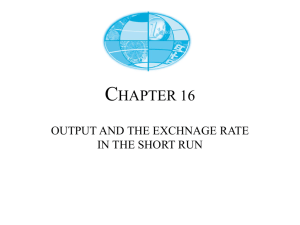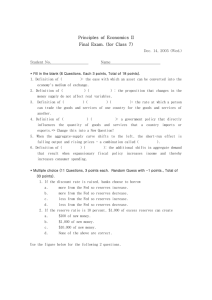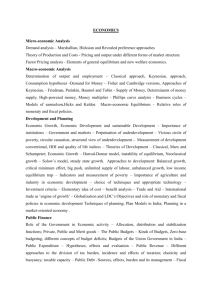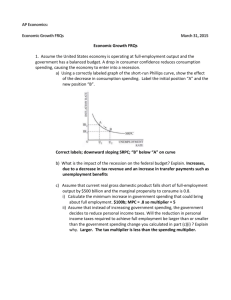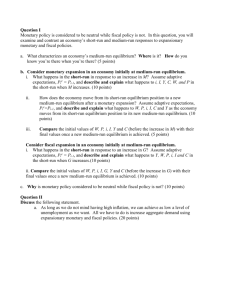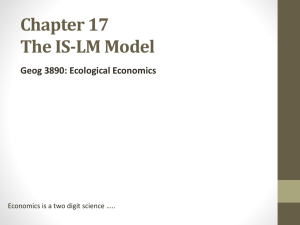M16_KRUG8283_08_IM_C16
advertisement
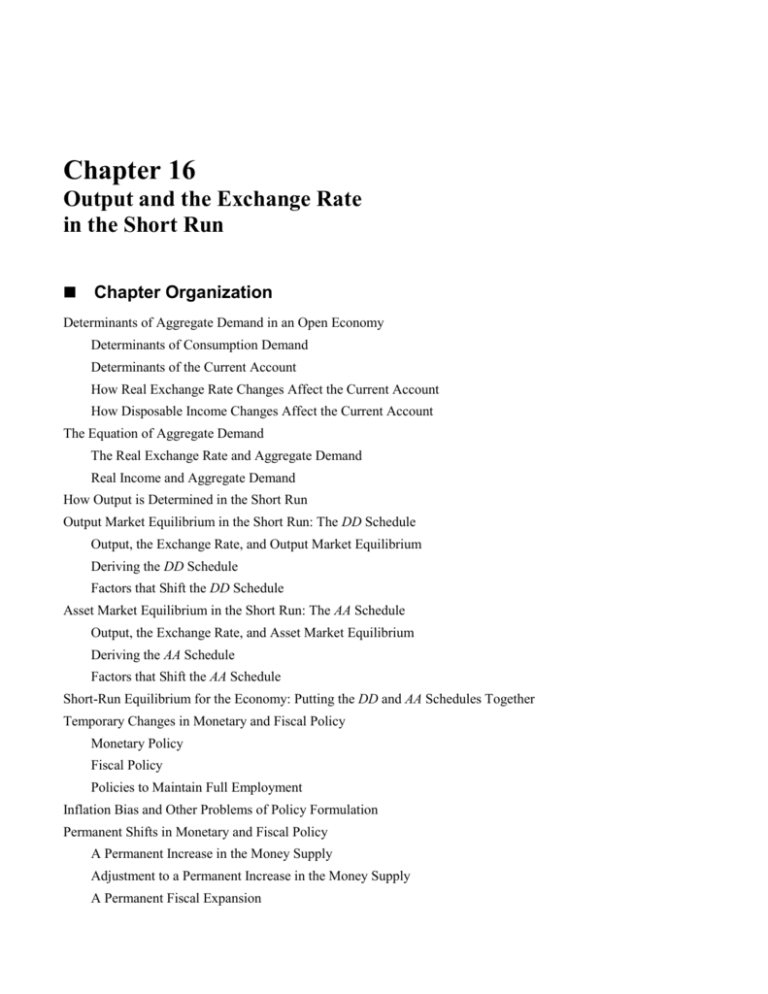
Chapter 16 Output and the Exchange Rate in the Short Run Chapter Organization Determinants of Aggregate Demand in an Open Economy Determinants of Consumption Demand Determinants of the Current Account How Real Exchange Rate Changes Affect the Current Account How Disposable Income Changes Affect the Current Account The Equation of Aggregate Demand The Real Exchange Rate and Aggregate Demand Real Income and Aggregate Demand How Output is Determined in the Short Run Output Market Equilibrium in the Short Run: The DD Schedule Output, the Exchange Rate, and Output Market Equilibrium Deriving the DD Schedule Factors that Shift the DD Schedule Asset Market Equilibrium in the Short Run: The AA Schedule Output, the Exchange Rate, and Asset Market Equilibrium Deriving the AA Schedule Factors that Shift the AA Schedule Short-Run Equilibrium for the Economy: Putting the DD and AA Schedules Together Temporary Changes in Monetary and Fiscal Policy Monetary Policy Fiscal Policy Policies to Maintain Full Employment Inflation Bias and Other Problems of Policy Formulation Permanent Shifts in Monetary and Fiscal Policy A Permanent Increase in the Money Supply Adjustment to a Permanent Increase in the Money Supply A Permanent Fiscal Expansion Macroeconomic Policies and the Current Account Gradual Trade Adjustment and Current Account Dynamics The J-Curve Exchange-Rate Pass-Through and Inflation Box: Exchange Rates and the Current Account Summary Appendix I: Intertemporal Trade and Consumption Demand Appendix II: The Marshall-Lerner Condition and Empirical Estimates of Trade Elasticities Online Appendix: The IS-LM and the DD-AA Model Chapter Overview This chapter integrates the previous analysis of exchange rate determination with a model of short-run output determination in an open economy. The model presented is similar in spirit to the classic MundellFleming model, but the discussion goes beyond the standard presentation in its contrast of the effects of temporary versus permanent policies. The distinction between temporary and permanent policies allows for an analysis of dynamic paths of adjustment rather than just comparative statics. This dynamic analysis brings in the possibility of a J-curve response of the current account to currency depreciation. The chapter concludes with a discussion of exchange-rate pass-through, that is, the response of import prices to exchange rate movements. The chapter begins with the development of an open-economy fixed-price model (an online Appendix discusses the relationship between the IS-LM model and the analysis in this chapter). An aggregate demand function is derived using a Keynesian-cross diagram in which the real exchange rate serves as a shift parameter. A nominal currency depreciation increases output by stimulating exports and reducing imports, given foreign and domestic prices, fiscal policy, and investment levels. This yields a positively sloped output-market equilibrium (DD) schedule in exchange rate-output space. A negatively sloped assetmarket equilibrium (AA) schedule completes the model. The derivation of this schedule follows from the analysis of previous chapters. For students who have already taken intermediate macroeconomics, you may want to point out that the intuition behind the slope of the AA curve is identical to that of the LM curve, with the additional relationship of interest parity providing the link between the closed-economy LM curve and the open-economy AA curve. As with the LM curve, higher income increases money demand and raises the home-currency interest rate (given real balances). In an open economy, higher interest rates require currency appreciation to satisfy interest parity (for a given future expected exchange rate). The effects of temporary policies as well as the short-run and long-run effects of permanent policies can be studied in the context of the DD-AA model if we identify the expected future exchange rate with the longrun exchange rate examined in Chapters 14 and 15. In line with this interpretation, temporary policies are defined to be those which leave the expected exchange rate unchanged, while permanent policies are those which move the expected exchange rate to its new long-run level. As in the analysis in earlier chapters, in the long-run, prices change to clear markets (if necessary). While the assumptions concerning the expectational effects of temporary and permanent policies are unrealistic as an exact description of an economy, they are pedagogically useful because they allow students to grasp how differing market expectations about the duration of policies can alter their qualitative effects. Students may find the distinction between temporary and permanent, on the one hand, and between short run and long run, on the other, a bit confusing at first. It is probably worthwhile to spend a few minutes discussing this topic. Both temporary and permanent increases in money supply expand output in the short run through exchange rate depreciation. The long-run analysis of a permanent monetary change once again shows how the wellknown Dornbusch overshooting result can occur. Temporary expansionary fiscal policy raises output in the short run and causes the exchange rate to appreciate. Permanent fiscal expansion, however, has no effect on output even in the short run. The reason for this is that, given the assumptions of the model, the currency appreciation in response to permanent fiscal expansion completely “crowds out” exports. This is a consequence of the effect of a permanent fiscal expansion on the expected long-run exchange rate which shifts inward the asset-market equilibrium curve. This model can be used to explain the consequences of U.S. fiscal and monetary policy between 1979 and 1984. The model explains the recession of 1982 and the appreciation of the dollar as a result of tight monetary and loose fiscal policy. The chapter concludes with some discussion of real-world modifications of the basic model. Recent experience casts doubt on a tight, unvarying relationship between movements in the nominal exchange rate and shifts in competitiveness and thus between nominal exchange rate movements and movements in the trade balance as depicted in the DD-AA model. Exchange-rate pass-through is less than complete and thus nominal exchange rate movements are not translated one-for-one into changes in the real exchange rate. Also, the current account may worsen immediately after currency depreciation. This J-curve effect occurs because of time lags in deliveries and because of low elasticities of demand in the short run as compared to the long run. The chapter contains a discussion of the way in which the analysis of the model would be affected by the inclusion of incomplete exchange-rate pass-through and time-varying elasticities. Appendix II provides further information on trade elasticities with a presentation of the Marshall-Lerner conditions and a reporting of estimates of the impact, short-run and long-run elasticities of demand for international trade in manufactured goods for a number of countries.
